What I Saw – by Jackie Philpott

Spider On My Boat
In 2021 a small spider came aboard my boat while I was sleeping, anchored off Heart’s Desire Beach, up in Tomales Bay. It settled in just under the aluminum trim along the port side of the transom and stayed for more than a year. While I slept it spun a web between the two bottom stainless parts of the stern pulpit. By the time I noticed it the next morning while I sat in the cockpit and drank my coffee, the web was already full of itty bitty bugs.
My spider came back to the San Francisco Bay with me. I never avoided its web when I hosed off my boat, and it would grow tattered and slop in the breeze for a while. Then the little spider would rebuild it and gradually it collected tiny dead bugs again. Not big bugs. My little spider was tiny, it didn’t seem to eat much. The web became a tiny cruising spider’s version of a food cabinet, full of dehydrated provisions. Once in a while I would catch glimpses of my spider scuttling out from under the aluminum trim. I didn’t ever look too closely. That was where it lived. My spider rarely appeared when I sat in the cockpit, so I felt that it would have been rude of me to intrude.
My spider rode along to the Delta in 2022. While we stayed up river my spider lived in a corner of my v-berth, where she collected mosquitoes that had found their way through the netting. We had a symbiotic relationship, that spider and I, and I sure wish I had taken a photograph of its web while I had the chance. But I didn’t.
Then, a few months ago, after a ferocious downpour, my spider was gone. I hate it when that happens. Loss. I find it very disconcerting.
Boat Projects
Unless you prefer to hand your boat over to the professionals at the boat yard, there are times when you have to work on your own boat. Some people love working on their boats. They may find it relaxing, they might actually enjoy it, or they may just not trust anyone else to do the job right. Such is life as a boat owner. I have such a story and here it is.
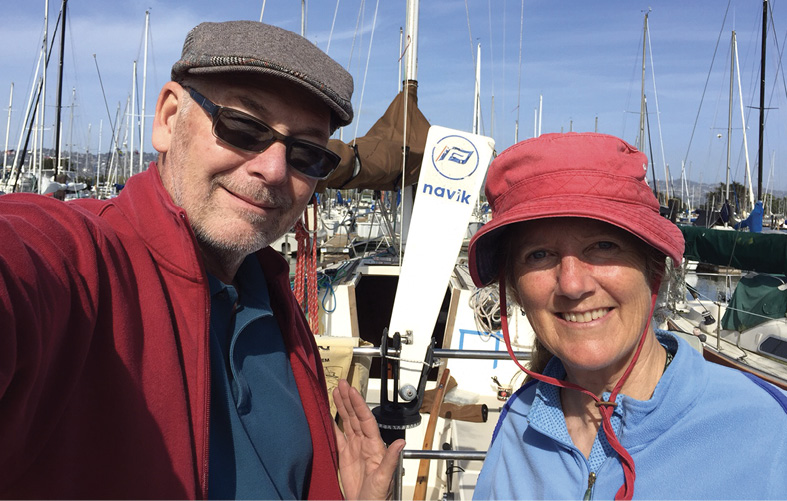
I kept my boat in the Berkeley Marina for ten years before moving to the Richmond Riviera in 2018. While I was in Berkeley, I met a fella named Bill who kept his inconsequential boat on O Dock near my own. I say that it was inconsequential because he didn’t really like it, and he was looking for another one. Bill was looking for the perfect boat.
In the meantime, like many of my dock neighbors over the years, Bill explained that my boat looked a little disheveled. He wanted to help me improve Dura Mater. To upgrade her in the looks department. Bill was on the hunt for the perfect boat. Until he found it he would nag me until I improved something – anything. And while I really appreciate these periodic suggestions, I recognize the interest for what it really is: Boat Displacement Syndrome. Dockmates are trying ideas out on my boat while they search for their own boat project.
When this happens I smile and nod. I know that these nice people with their ideas will eventually wander off and leave DM and me alone. If they are racers they suggest I replace a block here or there, switch out crummy rope with high tech rope. If they are cruisers they have a lot more suggestions. I parry their advances and wait for them to leave for Mexico or the Channel Islands. Eventually they will go away.
But Bill was different. He was determined to improve my boat. Bill had been an airplane mechanic before he became an air traffic controller at SFO. He knew a lot about engines and electronics and about stress. Bill said that being an air traffic controller was stressful and I believed him. Can you imagine? Bill was an intense guy and relentless in his attention to my sweet old fat boat. So, I gave him a small project. The project was to measure and install a bracket for my new-to-me Navik Windvane that I had bought in Mountain View.
About That Windvane
Early one evening in 2015 I found an ad on Craigslist for a used Navik Windvane. Naviks work beautifully and are hard to find. Legend has it that the Monitor Windvane company bought out Navik and then removed it from the market. I don’t know if that’s true or not, but if you would like to correct the record write me here.
I immediately called the phone number on Craigslist. A woman answered and in a hushed voice told me that I could come down and buy it the next day. Bring cash, she instructed me, and arrive between the hours of 10 a.m. and 3 p.m. Her husband would be at work.
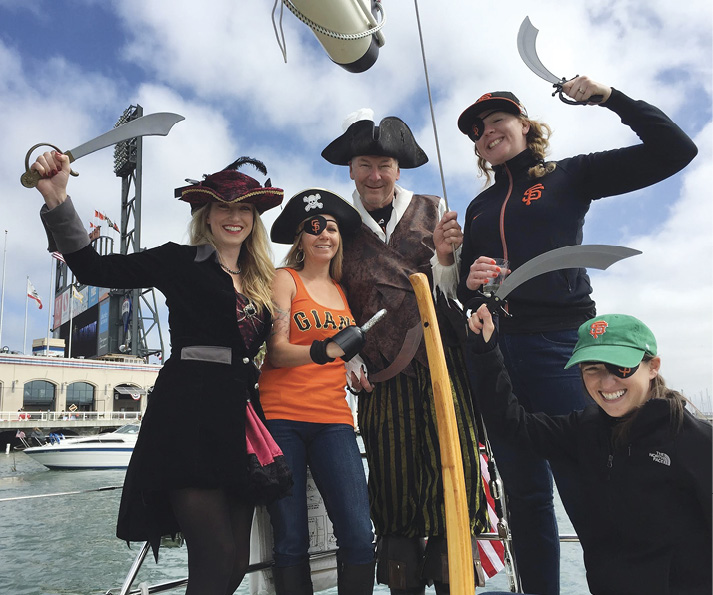
Huh? It sounded more like a drug deal, but I wanted that windvane. So, I drove down to a nice suburban house in the South Bay, parked on the street and rang the doorbell.
The house was lovely, its front yard surrounded by a white picket fence, and the garden was full of roses. The woman who answered the door didn’t look at all like the drug dealers in my neighborhood. The windvane and all its pertinent parts were laid out on the family dining room table. I gave her the cash and she helped me carry my new windvane out to my car. I asked what kind of a sailboat she had. She laughed and said, “Oh no! I don’t sail. My husband is a sailor and he spends way too much money on that damned sailboat of his. This contraption has been in a corner of our garage for years. Now shoo! Before he comes home!”
So, I shooed.
Meanwhile, back on O Dock, Bill measured and cogitated. When he was done he told me exactly what kind of bracket I needed in order that Dura Mater might finally have the very finest appurtenance. I knew it would make him happy, so I drove over to Chris’s Metal Shop at Svendsen’s which was located over in the Alameda Marina. Chris studied Bill’s drawings and agreed to build it according to the highest aircraft specifications. He told me to go buy parts off the shelf in the chandlery, and then he fabricated a beautiful, polished stainless steel bracket for my Navik Windvane.
It is the most beautiful windvane bracket the world has ever seen. Bill measured exactly where the bolt holes should go on my boat’s transom, then sent me deep down into her starboard lazarette to wait for further instructions. Bill drilled the holes from the comfort of the dock, then had me jiggle the bolts from inside (“Up an inch! No! further left! Not that left! The other left!”) as he guided the bolts onto the appropriate holes in the brackets. He had done such a careful job of measuring and cogitating that it fit together like a puzzle.
So, then I had a bracket and a windvane and Bill had satisfied his urge to improve my boat. It distracted him for a while. That done, he turned to a new project.
Bill didn’t want a messy boat like mine. He wanted a beautiful classic sailboat. For a couple of months he flew around the country looking at beautiful classic sailboats. Finally, he found a boat that had been kept in pristine condition in a warehouse. Seriously. She was a 37-foot Pacific Seacraft Crealock called Pristine. After travelling all around the country to look at boats, he had found Pristine in a barn. She had hardly ever been sailed, and was quite lovely and unblemished, in the way of boats called Pristine that have been kept in barns.
Bill bought this beautiful, unblemished boat and sailed her a couple of times. He sailed over to South Beach, made some sailing friends. Then he dismantled her entire electrical system with his beautiful, unblemished tools. They were tools from his days as an airplane mechanic. He painstakingly put the electronics back together again, with upgrades, so that Pristine’s system resembled that of an aircraft carrier. It was truly impressive.
Once that was done Bill turned his attention to her engine. He admitted that Pristine’s engine ran perfectly fine, but he wanted to improve her performance. Just a few tweaks here and there. Bill took that engine apart and put it back together until it finally satisfied him. I asked him about where he planned to sail her. Bill told me that he was really enjoying himself and I believed him. Maybe he felt self-conscious about not sailing. Maybe he just got tired of me nagging him to go sailing. Regardless, he moved Pristine to another dock in Berkeley. I would stop in periodically to find him down in the cabin working on something.
Bill replaced all Pristine’s standing and running rigging. He had new cushions sewn for her cabin and canvas to cover her sails. Then, one day? Pristine was gone. Months later I got an email from Bill. He had sold Pristine and moved to the Pacific Northwest. He had bought a big comfortable cabin cruiser.
His email was succinct: I HAVE GONE TO THE DARK SIDE.
So, remember Bill when you see your dock neighbor working endlessly on her boat. She may prefer it to leaving the slip to be on the water.
Ode To An Engine
If you recall, my boat’s engine is no longer tenable. How’s that for a euphemism? Specifically, I have been told that it is TOAST. So, I move on. The lost engine is symbolic, for me, of letting go of yet another something that has been a source of joy. But onward we go. Goodbye, engine.
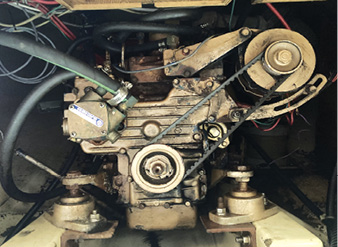
Of course, once an engine starts to go, it’s like any sailor. First your knees go, then your back starts to bother you. Next thing you know, you find yourself looking for a Wyliecat or an Alerion. The Wyliecat sailboat has just one huge mainsail, and the Alerions have a self-tacking headsail so you don’t have to use your shoulders to pull in the jib sheets. Maybe you have electric winches installed so you don’t have to work so hard to raise the main or sheet in the jib. After that it’s a slow slide to the comfort of a cabin cruiser. Indeed, who can blame you? More than one powerboat owner has said to me: “Sailboats seem like an awful lot of work.”
I’d like to take this opportunity to mention all the friends who have helped me with this Universal M15 and informed me along the way. Alone among the Universal diesel engines, the M15 was raw-water cooled and had no heat exchanger. Instead of freshwater coursing through its metal veins, salt water from the Bay and ocean surged all through it. No wonder the poor thing wore out. The diagnosis from Dr. Cree Partridge?
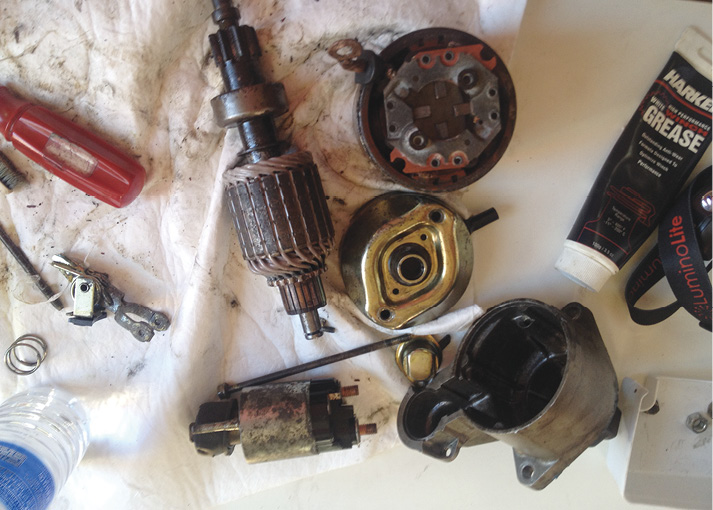
The engine has been disassembled to the point where the condition reveals deterioration beyond the possibility of reconditioning. Both the block and head revealed saltwater erosion that deteriorated cooling water courses, resulting in thin walls and oversized ports.
Between 2012 and its recent demise, I learned how to take the engine’s exhaust system apart and put it back together again, how to remove and replace the starter again and again, how to take the water pump apart and do the same, and also how to change the oil and the fuel filter and bleed the engine. All that and more I’ve learned from people who have patiently taken the time to help me or give me advice. I have also learned a lot about engines in general along the way. Many sailing friends have helped this engine to limp along over the past 12 years.
The first major issue with my engine was in 2013. There was a water leak dripping onto its starter. That caused the starter to rust, it couldn’t rotate and the engine wouldn’t start. It seems rusty parts have that effect.
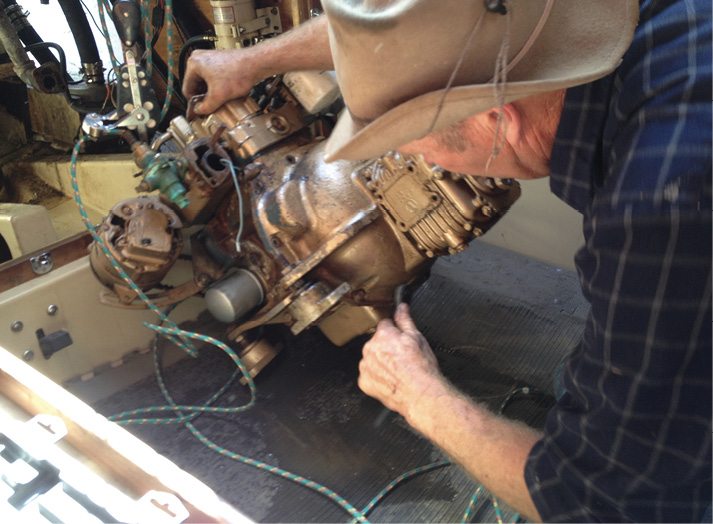
Dr. Partridge referred me to Genstar, which was located in a nondescript building in a semi-industrial neighborhood of West Oakland. The fellas behind the counter at Genstar were very knowledgeable. They gave me plenty of advice, then sent me on my way with a rebuilt starter that cost $288.85. I watched YouTube videos, then scrabbled around, figured out how to detach it from the engine block, then installed the new-to-me starter.
In order to go sailing, I would take the rusty starter off and replace it with the un-rusty one. I would take the rusty starter home, take it apart on the kitchen table, scrub the rust off and put it back together. Anything to sail, right? I got really good at replacing those starters, but it was tedious work. I did that for a while until a sailing friend, Dave Morris got tired of hearing me complain.
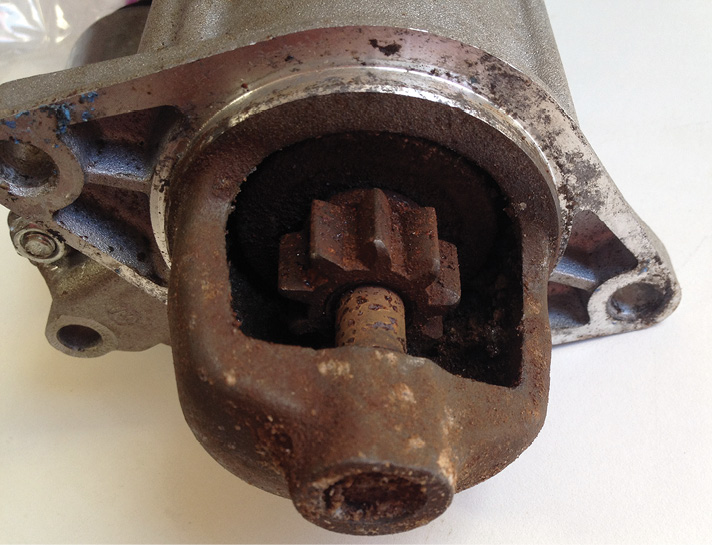
Years ago, before he became a senior pilot at American Airlines, Dave was a crop duster in the upper Midwest back when he was about 12 years old. Regardless, Dave knows tractor engines. After hearing from friends about my starter, he told me this, “It’s probably a freezer plug with a pin hole.”
“What’s a freezer plug?” I asked.
Dave explained, “That engine is a tractor engine, meant to run in the upper Midwest winter. It has freezer plugs. When the engine freezes, the freezer plugs pop out, keeping the engine from blowing. I think one of your freezer plugs has a pinhole in it, the water is dripping down onto your starter. We need to take the engine apart, replace the freezer plugs. Go on the internet, buy freezer plugs. Stainless steel plugs will last 10 years. Bronze plugs will last longer than you or me.”
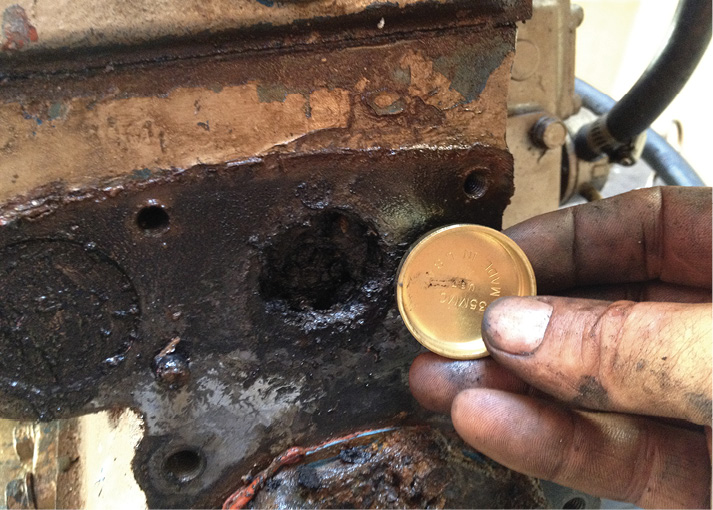
So, I bought bronze freezer plugs in several sizes. Dave came to Dura Mater and laid down a flattened refrigerator box on the cabin sole. He had brought a 3-foot long two by four and laid it across Dura Mater’s companionway. Then he sent me down into the lazarette to detach what I could reach. Then he detached what he could reach from the cabin. Using a block and tackle system attached to the two by four, he pulled, I pushed, and he lifted the engine right out of DM’s innards and onto the sole of her cabin. Dave made it look so easy.
He took the engine apart and laid it all out so I could see what the inside of a diesel engine looks like. We located all five freezer plugs. The plug directly above the starter had a teeny tiny pinhole that had been spraying water onto the starter, causing it to rust out every month or so. It could only be reached through the bell housing. Dave popped out the old plugs and tapped in five new ones.
Then we put it all back together and started it up again just as the sun set on the other side of the seawall in Berkeley Marina. I use the word “we” but really Dave did all the heavy lifting. He’s the brains and I was the monkey. I just did what I was told and crawled into and out of the lazarette a dozen or more times. That is why I have always called it my Engine by Dave. So now you all know.
Who Works In Boatyards?
Last month I wrote about the Boatworks 101 program at Spaulding Marine Center in Sausalito. I also posited the question of whether or not people who pay for an apprenticeship might value it more than people who don’t. In the interim I have chatted with some more people who have opinions about this issue.
In the week between Christmas and New Years Day I had the opportunity to ask Steve Hutchinson’s opinion about this issue. Steve learned how to build wooden boats “back in the day” in Maine and he had some thoughts that he shared with me.
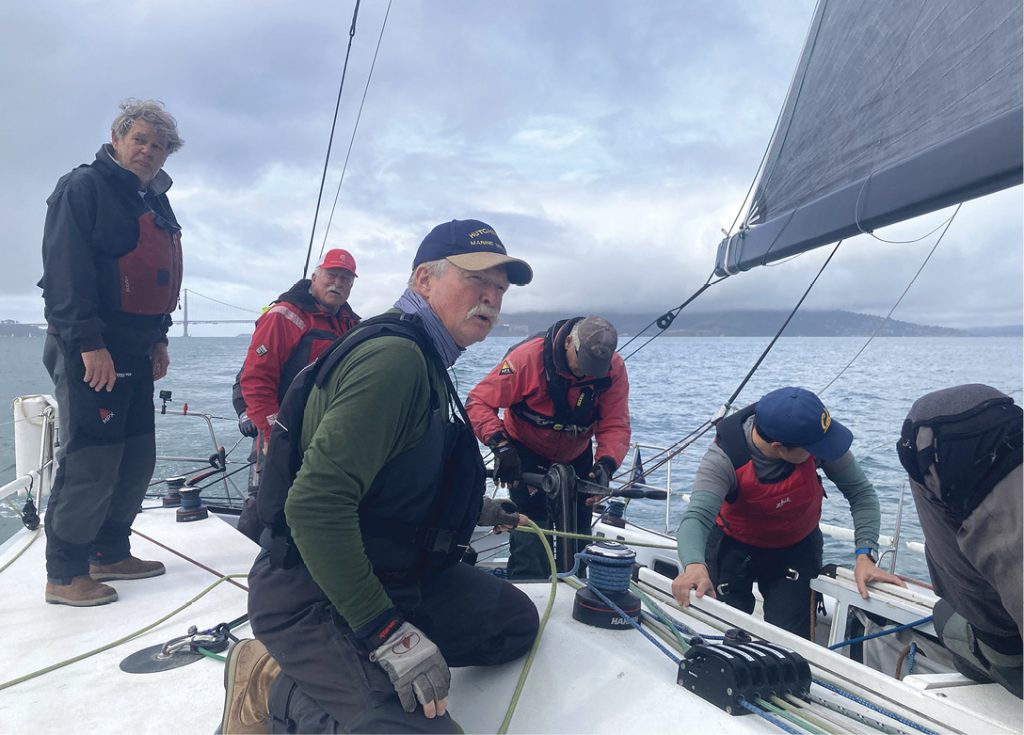
Although Steve’s own father became a veterinarian, both of his grandfathers worked in shipyards on the East Coast. He said, “This was in Chester, which is almost exactly like Richmond, California. It was an old town, located there because the railroad ran through it. One grandfather was a mariner and the other was a ship builder. They built Liberty ships during the war, and they built warships.”
As a child, Steve absorbed the understanding that his grandfathers’ experience as boat builders of the East Coast were part of the United States’ resistance to a war that everyone feared was approaching.
Steve: We weren’t in the war yet, but we weren’t letting England starve to death. So, we had to build a lot of ships. U-boats were sinking them, so the one way to resist was to have a lot more ships. We knew the war was coming. Germany had done it once and was intent on doing it again.
He described how one grandfather had made the transition from being a worker to becoming part of management.
Steve: My grandfather went to school to become a landscape architect. That’s what he wanted to do: build landscapes. But in 1932 he got out of school, the Depression was as deep as it could be, and who’s building landscapes? So, he got out of college and realized that the shipyards were hiring. They were building Liberty ships like CRAZY because we knew the war was coming. It was all about work ethic. It was a meritocracy. This is my grandfather’s story of how he became management: There was a welder and a burner. One uses a torch and one uses leads with an arc on it. So, somebody builds a ladder in the shop and it goes between the decks of the ship. Normally what used to happen was a rigger would rig on to this thing that somebody in the shop had already built. It had to be cut and then it had to be welded.
It used to be two unions, the burners and the welders. They didn’t get along. The burner goes down and cuts that thing, takes a piece of chalk, measures the angle, the rigger’s still hanging it, cuts it, then he walks away, says: “That’s my union job.”
Then the welder comes and welds it in. One uses a set of torches, the other uses a ground and a lead and a couple of welding ground.
My grandfather told management, “Someone could instead throw both bits of equipment over his shoulder, go down, do that job and eliminate both those unions.” So, he made that arrangement and then he was told, “You’re management.”
My grandfather was a go-getter. The unions hated it. But the way he figured out how to do that? He was very charming. He had the gift of gab. That guy could talk to anybody. They probably tried to shut him down, but he figured out a way to make it work. He’d keep the union guys busy doing other stuff and figured out that the shipyard needed to build ships faster. Our ships were needed because otherwise England would starve to death. They were blockaded.
I asked Steve about his own experience building boats.
Steve said, “When I was a young guy learning my trade there was a magazine called Fine Woodworking. It’s still published, it’s still a beautiful glossy, gorgeous thing. Something I read in that magazine was really clever, and it was this: ‘If you’re teaching people to be wood workers, what you really need to teach them is to survive on nothing. NOTHING.’
“In those days? I rented cheap apartments, shared a house. I could live somewhere on two hundred bucks a month. Any one of the guys that works here? Two hundred bucks a month is a dream. It’s two thousand dollars a month. And that’s the real problem today: The cost of real estate.
“Back in my grandfather’s time, after the depression, we had a big old war and we built housing; there were shipyard jobs back then and they needed people. All the people from the Dust Bowl, they came out here to California. And whoever didn’t come here went to the shipyards that my grandfather was running on the East Coast. Everywhere there could be a shipyard there was a shipyard.”
I asked Steve what he thought about the skill sets of young people coming out of Boatworks 101, but he declined to answer. Instead, he described someone he remembered from when he was younger, in a shipyard in Falmouth, Massachusetts.
Steve: He had been to the Maine Boat School and they hired him because we were building a lot of boats and we needed bodies. We had contracts to build more boats, they kept hiring guys. And they’d hire guys from the boat school and I would wait. Cuz the boat school guy, he had a REALLY nice sweater and the tweedbag accent. Tweedbag is old money. It’s a derogatory term for someone who went to prep school, and so he was a tweedbag. He came right out of the boat school. And I would wait. Because people who came out of the Maine Boat School didn’t work.
Work ethic is what you need in a boatyard. Instead, at the Boat School back then you were handed tools and given two years of hand-fed jobs. For example, a real craftsman takes an hour to hang a plank. In the boat school it takes a week. With 12 people! Everything is slowed down. It is dumbed down so much. So that same plank, that we would do in an hour? They do in a week in the boat school. The kids who come out, they’re ruined. Ruined! Totally ruined because nobody told ‘em “You’ve gotta hang that plank RIGHT NOW because I’ve gotta sell it! Right now! Get it on there!” They don’t teach ‘em that at Boat School.
Hopefully I don’t have to go back to building ships. I’m now in my early 60s. It will be younger people doing it. I don’t have the energy.
I commented upon the fact that Steve seems to have good energy as a crew member of the racing boat Glass Slipper. He acknowledged the fact, laughed and said: “I’m still pretending that I’m young.”
Boat Building
In previous columns I have written about people who have built boats from scratch. I wrote about a boat built in the financial district of San Francisco and one built in a garage in the Mission District. Steve Hutchinson helped build a boat in the Berkeley Marine Center named Glass Slipper.
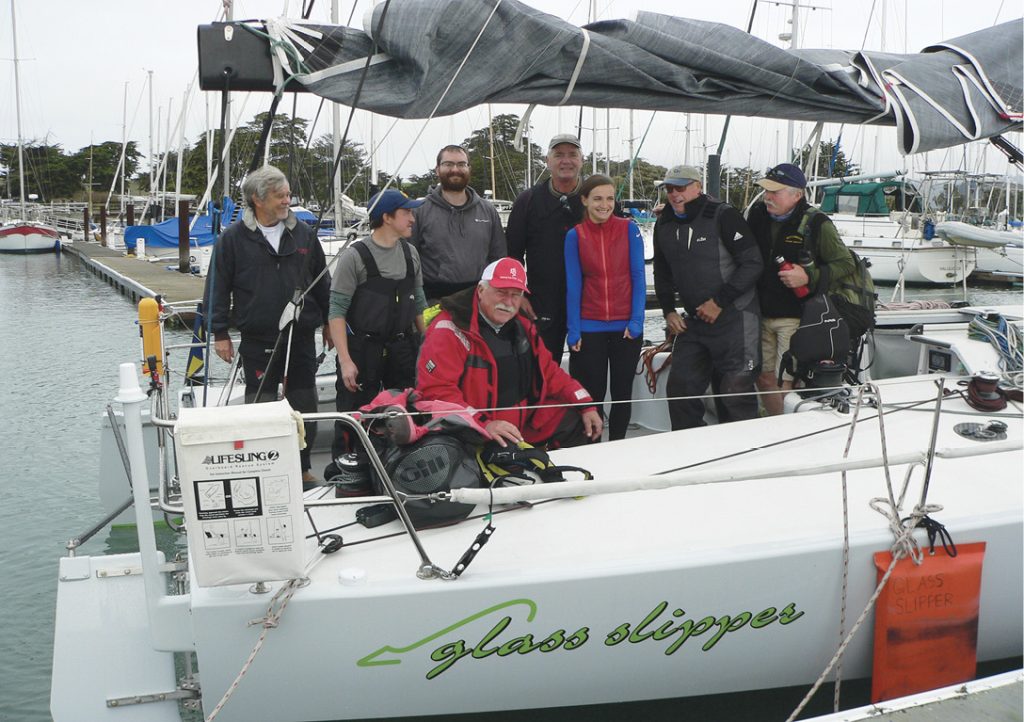
Here is a photo of the crew of the Jim Antrim designed Glass Slipper. Each person physically contributed to her creation over the past five years. And by the way, Glass Slipper’s owner is having a hard time finding insurance for her. Lack of insurance caused cancellations by several boat owners who had planned to race in the Pacific Cup Race from California to Hawaii during the summer of 2023.
This is a puzzle to me. The Pacific Cup organization holds boats to a very high standard regarding safety equipment and inspections. These are not derelict boats and their owners spend a small fortune preparing them. Participants are among the best sailors in the country and their sailing resumes are scrutinized carefully. Yet a significant number of the boat owners have been unable to obtain insurance. Why is this? I would really appreciate it if someone could explain it to me. The boats’ owners would really appreciate it if you could help them find insurance.
Iceboating In Wisconsin
In the February 2023 column I wrote this about ice boating:
I’ve been invited to race on ice in a two-seater iceboat. It should be fun and maybe you will like to read about it, too. So, stay tuned to this station and does anybody have a helmet I can borrow?
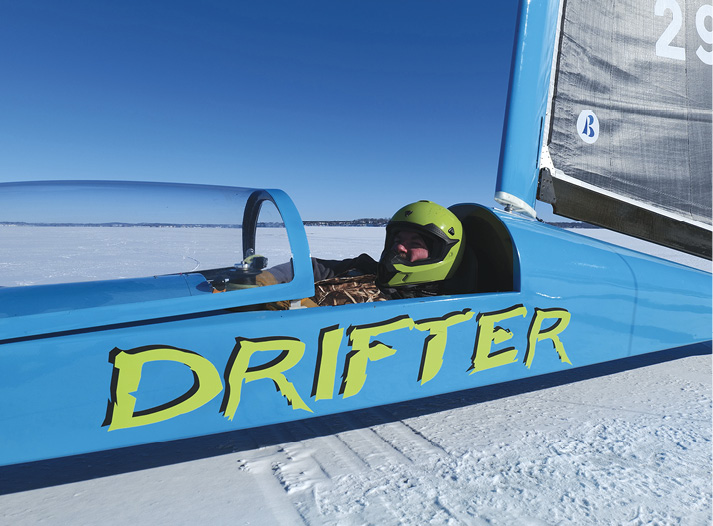
Since that column I have been surprised by how many people have told me that they themselves have ice-boated. One person told me that iceboating was unlike sailing: That everything I have learned to do while sailing is inherently opposite when iceboating; that sailing instincts might well prove deadly. For example, tacking on a sailboat is so different on an iceboat that I should forget everything I have learned. I was warned: “That move? That’ll kill ya.” Needless to say, I could hardly wait to get on an iceboat.
Between Jan. 13 and Jan. 20 of this year, the state of Wisconsin experienced a particularly brutal period of cold weather. Of course, I chose this week to visit the state. Who pays attention to forecasts? After all, here in California we’re always being told that it will rain. What Californian really pays much attention to that? In Madison, Wisconsin there was a wind chill advisory every day. The average temperature was negative degrees every day, deeper negative degrees every night. It was so cold it almost made me cry. Yes, I wore long underwear. Even at night. And a down jacket. Wool sweater, hat and gloves. But I promise you it wasn’t enough.
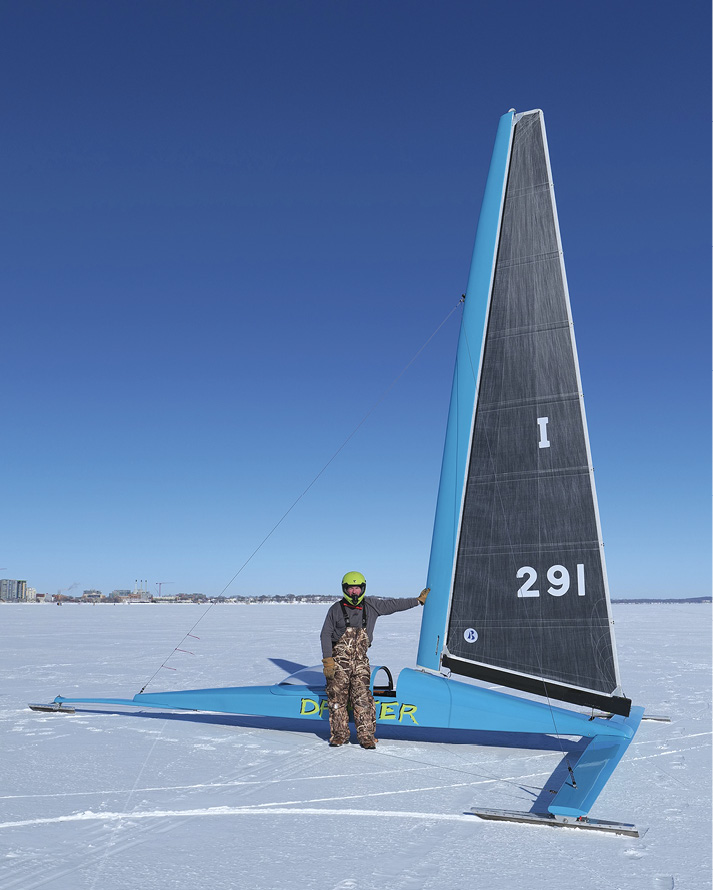
Last year I had hoped to be able to write about iceboating in Madison, Wisconsin. However, there were only a few days when the ice was adequate for that purpose, and they were never during the days of my visits. It was frustrating. I emailed the iceboat people until they became exasperated with me. They were unhappy enough by the lack of ice without that woman from California pestering them about it. So, I stopped emailing and just made my plans without trying to work around the ice.
I arrived in Madison in time for the first 2024 Regatta of the Four Lakes Ice Yacht Club. The Regatta had been cancelled because it was too cold. Yes, it seems that Wisconsin’s recent arctic blast presented “dangerous conditions.” So, no iceboating the first weekend I would be in town. I was dismayed but what can you do? If it’s too cold, it’s too cold.
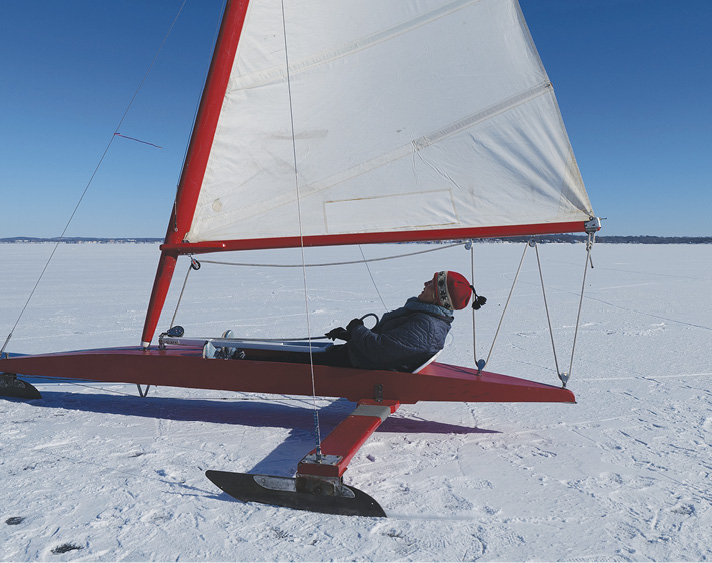
But wait! The Regatta was rescheduled for the next weekend! So, I ran my long underwear through the laundry and rescheduled my flight home to (rainy) California.
Did I have a chance to interview iceboaters? Why yes, I did. During my visit to the Land of Hard Water I interviewed iceboaters, admired and photographed their boats and even had the opportunity to sail a single seater DN all by myself. Carefully. What is a DN? Ah, that is a story for another column. Stay tuned and read the April Bay & Delta Yachtsman Magazine next month. It will probably be the one with a white powerboat on the cover. Watch for it. In the meantime, consider the winter wonderland that is Wisconsin, where people ride their bicycles across the lake on their way to play ice hockey. And when someone with a camera jumps out in front of them? They stop and respond politely.
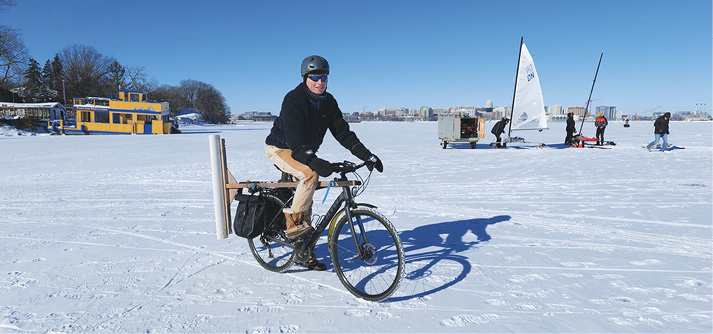
Look Around, Stay Safe
A reminder to everyone to keep your eye out for big boats on the Bay. Already the weather is warming up, people are starting to prepare their boats for the new year. On this bay we are fortunate to be able to get out on the water year-round. Sometimes, when you head out to fish or sail or just motor around, it’s easy to forget that you are not the only one on the water. You sigh, content in the belief that you are far away from the urban land experience all around. The sun starts to go down, you head for the harbor and you may be so relaxed that you forget to look behind you. Yikes! As the sun starts to go down, remember to turn on your running lights before sunset.
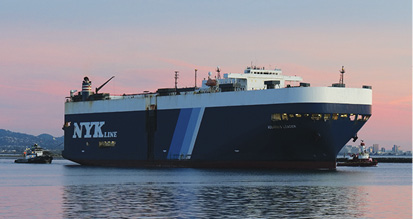
In the meantime, enjoy your time on the water and please write to jackie@yachtsmanmagazine.com to tell me about your own boating experiences. Thank you for reading, and let’s all be careful out there.



